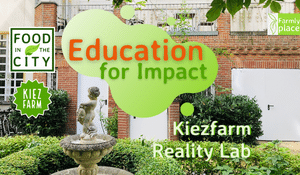It was a cold rainy winter's day deep in the west of the big city when a group of residents gathered in their neighborhood to talk about a special project. Fresh vegetables from the region had already disappeared from the weekly markets. Everyone was concerned about the lack of access to fresh and healthy food in their neighborhood, especially now in winter, and wanted to do something about it.
Kiezfarm Story
After much discussion and consideration, they decided to start their own neighborhood farm to grow their own fresh salads and some exotic herbs. The idea was quickly understood and at once on everyone's lips. Within a few days, all residents had agreed to help with the project. Together they started building the neighborhood farm and each contributed their own skills and resources. Some worked as artisans, others donated plants and seeds, and still others helped finance the project.
 The hydroponic plant soon began to produce, and it was not long before the first harvests arrived. Local residents loved the delicious salads and herbs they had grown themselves, and it wasn't long before they decided to sell part of their crop. This was the beginning of a successful joint venture that not only supplied fresh and healthy food, but also created jobs in the neighborhood.
The hydroponic plant soon began to produce, and it was not long before the first harvests arrived. Local residents loved the delicious salads and herbs they had grown themselves, and it wasn't long before they decided to sell part of their crop. This was the beginning of a successful joint venture that not only supplied fresh and healthy food, but also created jobs in the neighborhood.
The hydroponic facility became a meeting place where local residents came together to work, chat and share their passion for growing plants. The residents had proven that it was possible to get involved for a better future in their neighborhood by simply starting to work together and share their resources. The hydroponic plant was no longer just a way to produce fresh and healthy food, but as a neighborhood farm it was also a symbol of the power of community and the will to bring about change.
The Challenge
When implementing a neighborhood farm, there were a number of challenges that had to be overcome in order to be successful. Here are some of the most common challenges:
- Financing: A neighborhood farm requires a significant investment in equipment, materials and personnel to be successful. It can be difficult to raise enough funds to start and sustain the project.
- Resources: A neighborhood farm requires time, workforce and know-how to be successful. It can be difficult to find enough volunteers and professionals willing to contribute their time and skills.
- Legal challenges: There are often legal hurdles that need to be overcome before a neighborhood farm can be run. This includes structural requirements, permits and insurance.
- Plant care: It is important that the plants in a neighborhood farm are carefully cared for in order to be successful. This requires time, attention and ability about the needs of the plants.
- Marketing and sales: A successful neighborhood farm must be able to sell its products successfully in order to be financially workable. This requires a strong marketing strategy and a good understanding of the local market.
It is important to note that each added neighborhood farm has its own specific challenges, but with perseverance, cooperation and commitment, these challenges can be overcome to build a successful and sustainable network of neighborhood farms.
Role Models
Yes, a kibbutz can also serve as a model for a neighborhood farm, as both concepts aim to create a close-knit community and share resources to enable a better life for all involved.
In both concepts, community, cooperation and sustainability play an important role. The kibbutzim in Israel focus on agricultural activities and resource sharing, while a neighborhood farm is more focused on growing food in an urban environment.
In both concepts, members are seen as part of a larger community and work together to achieve common goals. This can have a strong sense of togetherness and a positive effect on the well-being and satisfaction of those involved.
Overall, it can be said that a kibbutz can serve as inspiration for a neighborhood farm, but both concepts have their own specific characteristics and challenges to consider.
Obstacles
In order to solve current problems with the costs and consumption of electrical energy in a sustainable project such as a neighborhood farm, there are several possibilities:
- Use of renewable energy: One way to reduce energy costs is to use renewable energies such as solar or wind energy. This can be achieved through the use of photovoltaic systems or small wind turbines.
- Energy efficiency: The use of energy-efficient equipment and systems can reduce energy consumption. These include, for example, LED lighting, energy-saving pumps and heat recovery systems.
- Water treatment: Efficient use of water can help reduce energy consumption. For this purpose, for example, rainwater harvesting, or a controlled irrigation system can be used.
- Community financing: Another way to reduce costs is to jointly finance the project. Through the use of crowdfunding or investments from local businesses, the project can be funded while supporting a strong community.
These are just some of the ways in which problems with the cost and consumption of electrical energy can be solved in a sustainable project such as a neighborhood farm. It is important to find flexible and creative solutions to enable a sustainable and cost-effective implementation of the project.
Solutions
 We asked the co-founder of the first Kiezfarm in Berlin Charlottenburg whether a Kiezfarm could also find support through educational work at schools.
We asked the co-founder of the first Kiezfarm in Berlin Charlottenburg whether a Kiezfarm could also find support through educational work at schools.
Pia replied with a smile: "Yes, a neighborhood farm can find even more comrades-in-arms through educational work at schools and shared learning experiences and thus also receive financial support. Through the use of hands-on learning methods such as school field trips, hands-on exercises and workshops, students can be informed and inspired about the value of sustainable agriculture and local nutrition. That's how we do it."
This has apparently already led to greater awareness of the project and contributed to higher participation. Parents and teachers could also be motivated by the educational work to take part in the project and to support it. Close cooperation with sponsors and private educational organizations has already opened up new financing opportunities, such as educational tours, partner funding or sponsoring.
Overall, educational work in schools and shared learning experiences can play an important role in attracting supporters and financial support for each neighborhood farm.
For two years now, virtual tours in the 1st Kiezfarm have also been very popular because they allow people to get an impression of the farm without being physically present. This can be especially useful if you don't live near the farm or if you want to check ahead of time before planning a visit or educational trip.
The experiences during the Corona pandemic have actually helped virtual tours become even more popular. Due to restrictions on social contact and travel during the pandemic, many people have resorted to alternative ways to gather impressions and information. Virtual tours offer a comfortable and safe alternative to physical visits.
In summary, virtual tours in urban farms are particularly popular with students due to their easy availability and flexibility, and the experiences during the Corona pandemic have contributed to their popularity even internationally outside Europe.
Can anyone have a Kiezfarm in their neighborhood?
In order to successfully implement a neighborhood farm in an urban neighborhood, it is important that the community is well organized and that all people involved are put on the same page. Here are some steps that can help you prepare:
- Formation of an interest group: A group of committed residents should come together to move the project forward and make the necessary decisions.
- Education and awareness: It is important that residents are informed about the advantages of a neighborhood farm and convinced of the idea.
- Planning and design: The stakeholder group should create a concept that includes the logistics, financing and organizational aspects of the project.
- Search for support: The stakeholder group can reach out to various organizations and experts who can help implement the project, e.g., local neighborhood initiative, universities, non-profit organizations, local government.
If you are looking for financial support, you can contact various bodies, such as senate administrations, regional funding, foundations or non-profit organizations. There are also special support programs for urban agriculture and sustainability that are worth exploring.
In summary, it can be said that a well-organized community of residents and close cooperation with local organizations and experts such as Farmlyplace GmbH are the best prerequisites for a successful implementation of a neighborhood farm in an urban neighborhood.






